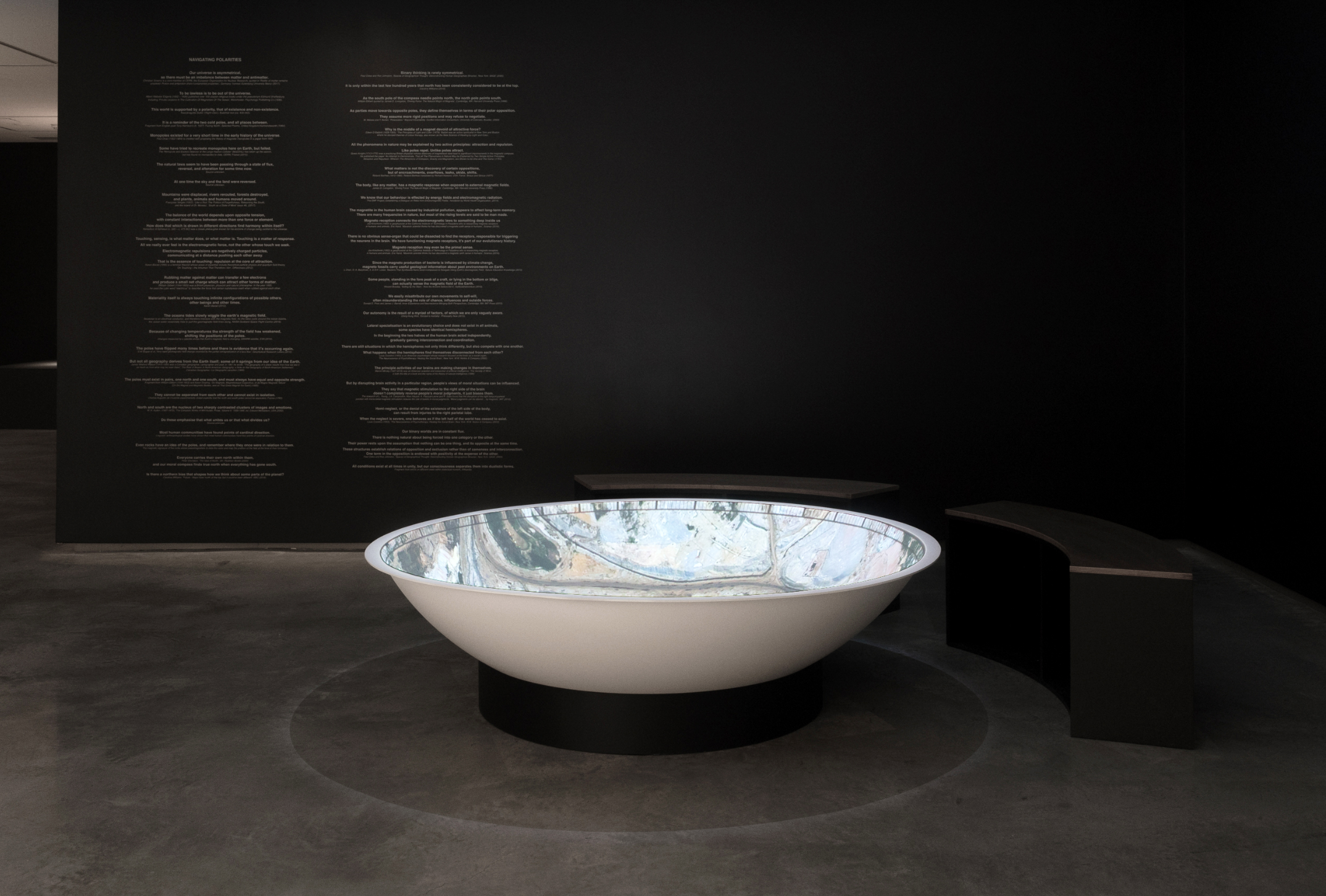Essay
Amelia Wallin
The star Polaris has earned the title of the North Star due to its position above the northern celestial pole. It is used to identify true north for those navigating the corresponding hemisphere (it is invisible from the southern hemisphere), yet during our earth’s 25,700-year precession cycle Polaris will remain the indicator for “true north” for only a fraction of time before the globe’s rotation appoints another North Star. In antiquity Polaris was not yet the North Star – instead the main celestial reference point was the ancient constellation Cynosura – but by the Middle Ages, it was a key point of navigation for the northern colonizers of the South. Our earth’s multidirectional orbit is a reminder that even our cardinal points are simply a matter of perspective.
There is an inherent bias in our language of navigation. Colonial and capitalist projects have left a mark on the ways in which one orientates oneself: North is up, South is down. The South American modernist painter Joaquίn Torres-Garcίa famously reversed the map: “From now on,” he proclaimed, “the elongated tip of South America will point insistently to the South, our North. Our compass will incline irremediably and forever toward the South, toward our pole.” [1] Even as our physical marker of North is slipping, ‘north’ as a concept remains foundational within Western thought. Marjolijn Dijkman’s immersive film installation Navigating Polarities (2018) considers this entanglement between astrology, navigation, and colonization. In a work that spans the cosmic to the cellular, Dijkman examines how the natural forces of magnetism that guided geographical and astrophysical exploration can subsequently affect dualistic thinking and our own sense of morality.
 Installation view, 21st Biennale of Sydney (2018), MCA, Sydney, AU. Photograph: silversalt photography.
Installation view, 21st Biennale of Sydney (2018), MCA, Sydney, AU. Photograph: silversalt photography.
Projected into an inverse dome, encircled by wooden bench seating, Navigating Polarities can be viewed from any position. A sphere, of course, has no top or bottom. The visual imagery combines mappa mundi, drone footage of mines, hand-drawn compasses, radiating lines, scientific animations of electrons, stock footage of migrating animals, and scientific experiments with magnetic particles conducted in Dijkman’s studio. The images shift, rotate, hum, and create the effect of a mesmerizing pool. The design of the installation echoes the eighteenth-century invention of Franz Mesmer: a circular tub known as the baquet around which afflicted patients gathered to be cured by surges of ‘magnetism’. As a doctor and astronomy enthusiast, Mesmer theorized that the human body contained radiant fluids that were sensitive to the gravitational pull of the planets. If blockages of these fluids occurred, Mesmer was able to restore the natural equilibrium of his patients using his own ‘animal magnetism’. Now understood to have been a master hypnotist, the doctor’s quackery has been immortalized etymologically in the verb ‘mesmerize.’
Western thought is organized by binaries: North and South, top and bottom, male and female, right and wrong. These binaries are not equally weighted, they are subject to what Derrida called “a violent hierarchy.”[2] The opening line of the narrative voice-over in Navigating Polarities affirms this imbalance, stating that the universe is asymmetrical. The script disperses dualistic thinking with reference to the writing of scientists, philosophers, theorists, postcolonial thinkers, and new materialist feminists. From this myriad of voices comes a narrative of flux, imbalance, change, reversal, creation, movement, and leakage. It reminds us that preconceived notions, the climate, and the entire universe are ultimately unstable.
 Prospect of Interception, Marjolijn Dijkman, installation at Onomatopee, 2016
Prospect of Interception, Marjolijn Dijkman, installation at Onomatopee, 2016
An earlier moving image work by Dijkman, Prospect of Interception (2016), also created a narrative through the assemblage of quotes, drawing from over one hundred sources to speculate on the effects of an asteroid colliding with Earth. The text was presented in multilingual subtitles, with the effect of an impassive, collective voice. The voice-over of Navigating Polarities is read by a woman, recalling the commentary of a documentary or educational video, but in a stream-of-consciousness flow. It is cyclical, designed to be entered at any point, without conclusion or epiphany. New materialist feminist Karen Barad writes that “objectivity is a matter of responsibility and not a matter of distancing at all.”[3] So it is in Navigating Polarities: rather than experiencing the detached objectivity of a science film, the viewer is entirely immersed.
The so-called “Age of Discovery” and its lasting effects on the world in regard to colonization and climate change are of continued interest to Dijkman. Previous works have looked to the Enlightenment to speculate about the possibilities for shared futures. Dijkman’s ongoing project LUNÄ (2011–present) is a replica of the eighteenth-century table of the Lunar Men – a secret society from the British Midlands, whose members have been deemed the “fathers of the Industrial Revolution” – which was used for their monthly meetings each full moon. LUNÄ now travels around the world for a discussion series with local speakers that expands the Lunar Society’s original scientific and technological debates to include diverse perspectives on art, education, and social justice.
Since the era of the Lunar Society and the Industrial Revolution, human intervention has contributed to the rise in temperatures currently affecting all forms of life. NASA has reported that the earth’s poles are tipping as a result of accelerated ice loss. Climate change even affects us on a cellular level: geophysicists have found evidence of magnetites in the human brain, specifically a magnetic iron oxide compound that is the result of air pollution. Illuminating the inherent connection between colonization and climate change, images in Navigating Polarities show gaping holes in the landscape from mining, while the voice-over describes these extractive forces: “Mountains were displaced, rivers were rerouted, forests destroyed and people and animals were moved around.” [4] Spanning the macrocosmic to the microscopic, from the balance of the earth to the balance between the two hemispheres of the brain, Navigating Polarities draws parallels between heavenly bodies and the corporeality of humans and animals. The film hones in on our cellular makeup and extends out to the ways in which we orientate ourselves in sync with the magnetic fields of the universe.
For Hannah Arendt, “in a universe where everything, if it moves at all, moves in a cyclical order,” mortality is a straight line that cuts through the cycles of biological life. [5] Navigating Polarities opposes the rectilinear life trajectory from birth to death – humans, the work suggests, are matter like any other matter, affected by the same laws of attraction and repulsion. Meditating on polarity enables Dijkman to think about the dualisms that govern Western thought and reside within our very cells, yet the core message of the work is one of plurality. In the affirmative words of Roland Barthes: “one must pluralize, refine, continuously.” [6]
____
[1] Joaquίn Torres-Garcίa, The School of the South Manifesto, 1935.
[2] Jacques Derrida, Writing and Difference, 1978.
[3] “Matter feels, converses, suffers, desires, yearns and remembers. Interview with Karen Barad,” New Materialism, Interviews & Cartographies, 2012.
[4] Françoise Vergès, “Like a Riot: The Politics of Forgetfulness, Relearning the South, and the Island of Dr. Moreau,” South as a State of Mind #6, 2017.
[5] Hannah Arendt, The Human Condition, 1958.
[6] Roland Barthes, Roland Barthes, 1977.
____